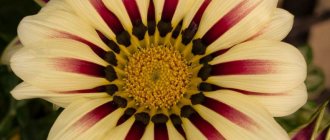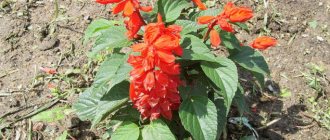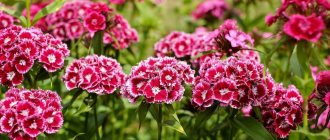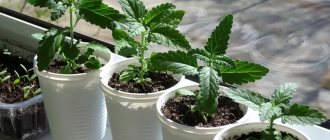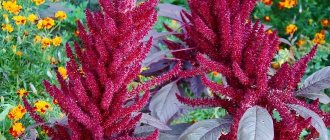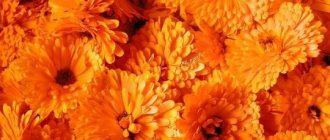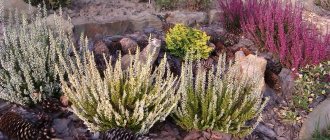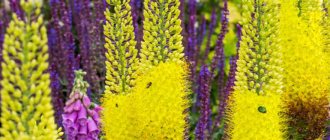A plant such as salvia (Salvia) is also called sage, and it belongs to the genus of perennial shrubby and herbaceous plants that are part of the family Lamiaceae or Lamiaceae. In the wild, they can be found in temperate as well as tropical regions of any part of the world with the exception of Australia. The name of this plant comes from the Latin word “salvus” which means “to be healthy”. The thing is that there are types of salvia, the medicinal properties of which have been known for a very long time. For example, a decoction of sage can quickly get rid of gumboil if you systematically rinse your mouth with it. There are almost 900 species of this plant, and they are all light-loving. It is customary to call those species that are used for decorative purposes Salvia. And the species used for medicinal purposes and as a herb are called sage. But we should not forget that salvia is the same as sage, only it is grown for decorative purposes. Medicinal sage was discovered during the Roman Empire, but ornamental salvia appeared in European countries only in the 18th century during the era of the horticultural boom. A separate plant is Salvia divinorum, which is called narcotic sage or “fortune sage.” Its leaf blades contain salvinorin, which is a psychoactive hallucinogen. However, below we will talk about salvia, which is a beautiful shrub plant.
Description of salvia, types
All species of this flower, and there are almost 900 of them, are extremely light-loving. Florists call salvia species that are grown exclusively for decorative purposes. Wild-growing individuals are known to everyone under the name “sage”, which is used in cooking and in healing practice.
The shoots of the plant are tetrahedral, erect (sometimes ascending), the height depends on the specific variety, and ranges from 20 to 120 cm. The leaf blades are usually entire, but can also be pinnately dissected. Their outer side is dark green, and the lower side is whitish.
The ends of the shoots are decorated with complex whorled inflorescences, consisting of small flowers and resembling a spike. Sometimes it can look like a panicle and reach a length of 20 cm.
All available types of salvia, depending on biological characteristics and agrotechnical characteristics, can be divided into 3 groups:
- Subtropical species that are cultivated as annuals in the middle zone. They need warmth and constant hydration. May die in light frosts.
- Mediterranean varieties are more frost-resistant and can withstand drought. However, they need loose soil and mineral fertilizers.
- This includes all frost-resistant species . They bloom lushly in the second year, and only need shelter when natural cover is scanty.
Popular varieties
In city flower beds and private flower beds you can often find the bright colors of annual salvia of various colors. Flower growers are most willing to fill their flower beds with the following varieties:
Salvia sparkling
Salvia sparkling is a perennial plant, but in the middle zone it is cultivated as an annual. Compact bushes have a height of 20-80 cm and have fairly dense foliage. The opposite petiolate leaves are ovoid in shape and dark green.
Large flowers of irregular shape are endowed with a double perianth. In addition to the usual red color for this species, others are also often found: pink, white, purple. Salvias bloom from June until the first frost.
The varieties Salvator, Sahara, and Fire Star are very popular.
Salvia vermilion
Straight branching shoots of salvia grow 50-70 cm. The green mass has dense pubescence on the underside, and the front side of the finely serrated leaves is bare. A loose inflorescence of whorled flowers can reach 30 cm in length. Salvia blooms in July and pleases the eye until frost.
Among the popular varieties are: Sherry Bloss, Lady in Red.
Salvia powdery
The pyramidal bush can reach a height of 90 cm. Mealy salvia is quite unpretentious and blooms for a long time. Plants of this species are large - tall peduncles have long inflorescences with 2 centimeter flowers.
Flowering of this type of salvia begins in August. Most often the flowers are blue, but some varieties bloom white.
Flower growers fell in love with the following varieties: Anschuld, Victoria, Strata.
Salvia green
The only decorative variety of green or variegated salvia is Horminum. There are many soft pink flowers on long simple inflorescences. They are very effectively set off by bracts that have rich pink or purple tones.
Popular varieties are: Pink Sandy, Oxford Blue, White Swan.
Salvia whorled
The bush with ascending shoots and dense pubescence is small - only about 40 cm. The leaf blades have an unusual shape; dense whorls contain up to 30 blue-lilac flowers.
The most striking representative of Salvia whorled is the Purple Rain variety.
Salvia dandelionifolia
This herbaceous plant has a basal leaf rosette. Each part of salvia is endowed with a pleasant aroma. The leaves are pinnately dissected, their undersides are pubescent. Simple inflorescences are quite long and can reach 30 cm.
Botanical description of the plant
Salvia (varieties, photos of flowers are presented in the article to familiarize yourself with garden culture) belongs to the herbaceous genus of shrub crops. The flower can be grown as an annual or biennial plant. It can withstand frost normally and does not need direct sunlight. However, continuous shadow negatively affects the culture.
Photo of red Salvia variety
The flowers are presented in a spike-shaped form, which consists of 35 small inflorescences. The latter initially bloom at the bottom. The petals can be colored pink, red, blue, lilac, yellow or white. The flowers are two-lipped and fragrant. At the end of the flowering stage, dark-colored fruits and nuts begin to form.
Depending on the variety, the height of the bushes can reach 30-160 cm. The pale green foliage is whole, elongated, pinnately dissected, soft and terry.
The stem is quite juicy and powerful. However, it is very easy to break. Closer to winter, the stem begins to become woody. With the arrival of spring, its top freezes, so it needs to be removed. The root system is powerful and grows well. The flowering period begins in June and ends in October. Salvia can be cultivated in open areas and at home.
How to grow salvia from seeds
To grow healthy seedlings, gardeners need seeds, soil, container, diligence, and attention.
Preparing seeds for sowing
Since salvia seeds do not need stratification, preparation of planting material is carried out on the eve of planting. Seed material can be purchased or collected personally. Sometimes bagged goods are already pre-processed and granulated; in this case, it does not need pre-planting treatment and is sown directly into the soil.
However, it should be noted that granular seeds need to be planted a little earlier than usual, since it takes some time to dissolve the artificial mineral shell.
Simple seeds are subjected to the following treatments:
- Germination test. Place the seeds in a deep plate with warm water for 1.5 hours. Then the water with floating pacifiers is drained. High-quality seeds are collected at the bottom.
- Disinfection. The grains wrapped in a piece of bandage are kept in manganese for a third of an hour, followed by washing.
- Drying. Before planting, the seeds are dried on a sheet of paper. To prevent the core from drying out, do not place the grains on the battery.
Selection of soil mixture
If you don’t want to buy ready-made soil, it’s easy to prepare it yourself. Salvia puts forward the following requirements for it: nutritional value, lightness, water permeability.
You will need coarse sand, peat and leaf soil. A well-mixed mixture will need to be re-sowed twice:
- Place on a large sieve;
- Place in a fine sieve.
The containers are filled as follows:
- The very bottom is lined with expanded clay, approximately 1 cm thick;
- Half the container is filled with coarse soil;
- Next, add fine soil.
To destroy possible pests, the soil is watered with hot, strong potassium permanganate and left to rest for a week.
Sowing salvia seedlings in containers
Any low container is suitable for salvia seedlings. To prevent stagnation of water, the bottom is pierced several times. Ready-made factory containers already have holes and are equipped with pallets.
- The soil is pre-moistened so that the seeds stick better. Some gardeners mix salvia seeds with sand to ensure more uniform planting and prevent thickening. Granular material is larger and easier to sow, so the seeds are placed in a 3x3 pattern.
- The spread out seeds are lightly sprinkled with earth. Often gardeners simply press them lightly into the soil. The container is covered with glass or film.
Seeds germinate within 8-12 days. The temperature is maintained around +22ºС. The sprouts almost always emerge with a seed cap, and it is advisable to help them get rid of it.
How to sow salvia, the best way - video
General information about salvia oakberry
Plant characteristics:
- Its branches are tall, reaching 120 cm.
- The leaves are large, ellipsoidal, ribbed, pointed at the ends.
- The flowers are collected in inflorescences and are painted in red, lilac, violet, white or purple tones.
- The plants are unpretentious. Perennial species are frost-resistant and can withstand cold temperatures down to -18 degrees.
Salvia oakberry is grown as a perennial plant.
Today there are about 700 species of salvia. Of all the types, it is considered the easiest to care for and frost-resistant. In the wild, it can be found in the foothills of the Crimea, on the European territory of Russia, and in the Caucasus. It is also found in some places in Central Asia and Siberia. Salvia grows along river banks and on mountain slopes.
This is not the tallest type of sage; the length of straight branches can reach only 60 cm. They are heavily branched and pubescent. The leaves at the bottom of the branches are large, oblong, glabrous, pointed at the ends. In the upper part the leaves are much smaller in size. The inflorescences are long, up to 40 cm. The flowering period lasts all summer.
Caring for salvia seedlings
The emerged seedlings begin to open gradually, lifting the glass for a short time, increasing it daily.
Lighting
Seedlings need light for 12 hours, so additional lighting is indispensable. The container can be placed on window sills, but be sure to turn on additional phytolamps in the morning and evening.
Humidity and watering
From the moment of sowing and in the future, the soil should not be allowed to dry out. Moisten the seedlings with a spray bottle, or by pouring water into trays, from where it is absorbed into the soil through the drainage holes.
Excess moisture causes rotting of the roots, so it is better to dust the surface with ash.
Feeding
3 weeks after germination it is useful to feed them. Use complex formulations purchased in stores. To activate the growth of salvia, use Fertika and Agricola fertilizers.
Picking
For salvia, as for any seedling, a strong root system is very important. This can be achieved by double picking.
The first peak occurs during the period of 1-1.5 months of plant life. This is not too late, since salvias are slow-growing. In any case, diving is not done earlier than before the appearance of 2 permanent leaves.
Transplantation is usually carried out into the same containers, only at a greater distance. Can also be transplanted into individual containers. The distance is maintained at about 7 cm; deepen to the cotyledon leaves. Picked seedlings should be covered with paper for a couple of days.
3 weeks after the first pick, the procedure is repeated. The containers chosen are sufficiently capacious, since salvia roots grow well.
Picking salvia allows you to solve problems that will be useful to the plant throughout its life:
- Root development is stimulated;
- During picking, it is possible to select the strongest plants;
- Interweaving and, as a consequence, deformation of the roots are prevented;
- When picking, seedlings are examined to identify diseases and prevent them;
- Seedlings that begin to outgrow are buried a little deeper to slow down their growth if it is too early to plant.
After 4-5 leaves appear, the top of the seedling is pinched, causing maximum tillering. A couple of weeks after picking, salvias notice increased growth.
How to properly pick salvia seedlings - video
Propagation by seeds
You can propagate oak sage from seeds in two ways:
Sowing in a flowerbed
| |
Seedlings
|
When to replant salvia in open ground
Like all heat-loving crops, salvia does not like frost, so it is planted only after stable heat has developed. In the middle regions this is approximately the first ten days of June.
The planting holes need to be spacious so that the roots do not clump together. Add superphosphate or ash and a handful of humus to each hole. It is better to plant during periods of less sun activity, or shade the seedlings for 3 days.
When choosing a place for salvia, you need to pay attention to some nuances and immediately make adjustments for the location:
- Salvia is prone to lodging. The seedlings are either covered with soil or planted thicker.
- The activity of flower development may interfere with other plants. You need to maintain a distance of 30 cm.
Features of ripening and flowering of annuals
When buying annual seeds, you need to be prepared for the fact that your flowerbed will bloom no earlier than mid-May, even if you grow seedlings at home, on windowsills. When sown directly in the ground, the plants will bloom even later - by June. And the reason is not only that most annuals produce their first flowers 40-45 days after the seeds germinate. The speed of plant maturation will also be affected by the weather. If May turns out to be cold, with frosts, then the hatched sprouts will be easily damaged, stop growing, and their growing season will increase. Even the most unpretentious marigolds do not like contrasts between night and day temperatures. Therefore, gardeners have an unspoken rule: to plant seedlings only after the end of the May frosts, and if they were sown directly into the ground, then cover them with spunbond or other non-woven material at night.
Possible problems with seedlings and their solutions
Salvias are practically not susceptible to any diseases. The damage is caused by insects and slugs, which can be successfully combated using traditional methods. Often, when growing seedlings, gardeners are faced with some unpleasant situations:
- Shoots do not appear for a long time . This situation can be observed if the swollen seeds were still overdried. It is best to sow again, since even if the previous seeds sprout, the sprouts will not be completely healthy.
- The sprouts stay in their caps for a long time. Seed skins remain on plants for a long time if the seed material is not of high quality. The seedlings should be slightly moistened and, using a toothpick, help get rid of the seed coat. Then the seedlings are fed with complex microelements.
- Flowering is delayed or completely absent . If the plant has pale foliage and the stems are very elongated, it means the whole problem is a lack of light. Salvias are quite demanding about this: no light - no color. If the problem is noticed at the beginning of summer, then you can try to transplant to a sunnier area. If the bush develops normally, the color is natural, rich, and there are few or no buds, then the salvia is simply fattening from excess nitrogen. In this case, it is sprayed with superphosphate.
Plant pests and diseases
When planting a plant in open ground, do not allow it to be a neighbor to vegetable crops, as they can cause pests such as whiteflies. They can also be attacked by spider mites. These pests can be fought, but this fight will cause great harm to the plant.
Snails and slugs are the main enemies of salvia, and all because it has lush foliage . To combat them, you can use mulch and sawdust, and you also need to monitor soil moisture.
Mulching the soil around flowers helps to control pests.
How to properly care for salvia in summer
Salvia is very easy to care for. Simple standard procedures include watering, weeding, mulching, loosening, and fertilizing.
What to feed for abundant flowering
In order for salvia to delight with an abundance of color, it needs proper nutrition. In the flowerbed, flowers are fertilized 5-7 days after planting. The menu offers her growth stimulants and minerals. As soon as the plant begins to form buds, the next feeding is carried out.
Salvia will bloom abundantly if it manages to develop its above-ground part well. Like nothing else, this is facilitated by nitrogen, found in proper quantities in bird droppings, humus, and manure.
The infusion of such organic matter should be poured over the transplanted salvias, and in a very short time they will become much healthier. Flowering is also promoted by potassium, which helps absorb water and phosphorus, which ensures normal development.
Salvia Cassiopeia
Some flower growers who do not have the proper experience and are poorly versed in various fertilizers can use tips from manufacturers. Many nutritional compositions speak for themselves: Ovary, Bud, and so on.
Experienced flower growers prefer traditional methods to all factory-made fertilizers. To prolong and enhance flowering, they use an ash solution. Also pour boiling water over the skin of bananas and peel potatoes for a week.
Before the buds open, it is useful for salvia to water it with water infused with egg shells.
Reproduction methods
Salvia reproduces in several ways. Perennial varieties can be divided from the rhizome, propagated by cuttings, and sown by seeds. But one-year-olds and biennials are propagated exclusively by seeds: direct sowing and through seedlings.
Seeds are sown in spring and autumn, before winter. However, there are varieties that can only be grown using seedlings. These are all varieties belonging to the type of salvia sparkling.
When and how to collect your seeds
High-quality material will be obtained exclusively from varietal flowers. Fading inflorescences are cut and dried. Do this not in the sun. The inflorescences are laid out under a canopy in the fresh air or in a ventilated room. You can collect a lot of seeds from dried seed pods.
Picking salvia seedlings
Salvia seedlings are a real “slow-witted” in matters of growth - it comes to picking only a month and a half after sowing. If you get a “very fast” variety, focus on the leaves - you can pick salvia when two true leaves have formed on each plant.
Gently pry the sprouts with a fork or small spatula and transplant them into separate containers. Pots for salvia seedlings should be about 10 cm in diameter and 15-20 cm deep. The same soil in which you sowed the seeds will do.
After picking, carefully water the bushes and cover them from direct sun with newspaper - for the next 2-3 days they will be in a state of stress, and the sun's rays can burn them. Continue to water the harvested salvia seedlings 1-2 times a week.
After 3 pairs of true leaves form on the bush, it can be pinched. In this case, it will become more lush, but flowering will be delayed by 1-2 weeks.
How to grow perennial salvia
These flowers are planted once, and they will delight you with their blooms every year. There is no need to tinker with seedlings or prepare beds for direct sowing every time. Perennials are planted in metropolitan areas, in dachas, and can be found in meadows under natural growing conditions.
They are distinguished by a more powerful root system, which allows the plant to take care of itself, extracting precious moisture from the deep layers of the soil. Their stems are thicker, often with already lignified shoots.
Popular types
The most popular perennials planted in city flower beds are:
- Salvia oakberry. The stems of the plant are relatively low - only up to 60 centimeters. The lower petiole plates are always larger than the sessile ones located above. The inflorescences consist of several lateral branches.
The standard predominant color of the flowers is blue-violet, but the rather large purple bracts often catch the eye. The flowering of the Salvia oak grove species lasts 2.5-3 months: from late June to mid-September.
Plumosa
The most popular varieties are Amethyst (pink-violet), Mainakht (blue-violet), Plumosa (lavender).
- Salvia sticky. The bushes grow quite large - almost 1 meter. The flower has a large number of pubescent glandular shoots. The leaves are more like triangles of yellow-green color with a serrated edge. Salvias bloom towards the end of summer and bloom until frost.
Salvia glutinosa
- Salvia
nemorosa '
Rose Queen'
.
The low half-meter bush is distinguished by its long flowering time. Spike-shaped inflorescences can have different shades, depending on the variety
Salvia Rose Queen
Popular varieties are: snow-white Snow Hill, and dwarf varieties - Blue Queen (lavender), Rose Queen (pink).
Perennials include popular species of Ethiopian salvia and meadow salvia.
Features of cultivation and care
Perennial salvias are more difficult to care for. Many inexperienced flower growers are often perplexed about this, because, it would seem, there is no need to bother with seedlings and the plants are much hardier. However, not everything is so simple: perennials need sanitary and formative pruning, preparation for successful wintering.
In the spring, the bush is formed by cutting off shoots that are too elongated, not allowing them to become bare. After flowering has finished, all inflorescences should be removed. Just before the cold weather, all the old stems are cut off from the plant, leaving small stumps with buds, as well as young greenery.
It is advisable to cover the salvia for winter dormancy - if the winter has little snow and frost, the roots of the crop may be damaged and the flowering next year will not be so generous. Flower beds are covered with sawdust, spruce branches, and dry leaves.
Characteristics of varieties
Salvia is considered a perennial crop. However, in Russia it is grown as an annual or biennial plant.
The following varieties of flower shrubs are considered the most popular:
| Variety name | a brief description of |
| Salvia green | The annual shrub can reach approximately 60 cm in length. The stems are erect and have hard pubescence. The flowers are collected in inflorescences reaching approximately 30 cm in length. The color can be pinkish, lilac and green. |
| Salvia Cambridge | The bush is not too tall. The bracts are pinkish, blue or light in color. Prefers to grow in well-lit areas. Withstands cold climates. The culture can survive temperatures reaching -2 °C. Used mainly for flower beds, group plantings and borders. |
| Salvia comet | A lush and small bush, reaching approximately 25 cm in height. The foliage is shiny and green, with prominent veins. The inflorescences are quite dense, with reddish flowers. The flowering stage lasts from June to September. It is permissible to cultivate on the balcony and use it to create ridges and flower beds. |
| Salvia Coster | It is considered an annual plant, reaching approximately 60 cm in height. The inflorescences are very lush and red. The culture loves warmth and tolerates drought well. The soil cover should be neutral and have good water permeability. Suitable for cultivation in containers on the balcony. |
| Salvia red | The length of the bush is approximately 70 cm. It has dense pubescence and a large number of branches. The foliage is oval, with serrated edges. The outer side of the plate is pubescent, and the inner is smooth. The inflorescences are not too dense and can reach approximately 30 cm in length. The flowers are deep red. The flowering stage begins in the middle of the summer season and ends with the arrival of frost. |
| Salvia sparkling or brilliant | The shrub is 20-80 cm long. The foliage is entire and has a stalk-like shape. The outer side of the plate is predominantly dark green, and the inner side is light green. The flowers are large, with a double perianth. The petals are lilac, blue, light or scarlet. Brushes can hold up to 6 pieces. The length of each brush reaches approximately 25 cm. The flowering stage begins in June and ends in autumn. Pink varieties are characterized by a short flowering stage. Lilac types of flowers have thick pubescence and velvety texture. |
| Salvia Scarlet | Considered an early variety. Flowering occurs at the beginning of the summer season and continues until the first frost. Can reach approximately 25 cm in length. The shoots are greenish and the inflorescences are red. The length of the latter varies within 15 cm. It prefers to grow in sunny areas. The variety can be used to create flower beds and rocky hills, and can be cultivated on the balcony. |
Salvia in the flowerbed and flower beds - photo
Salvia is a very popular flower. It is most often planted in flower beds and flower beds. Salvia looks good in flowerpots or garden containers, which can be placed on balconies and well-lit garden areas. Bright salvia goes well with many types of ornamental plants: lobelia, marigolds, petunia, zinnia, ageratum, alyssum, silver cineraria.
Salvia combined with lobelia
Salvia with marigolds
Perennial Salvia
Salvia with cineraria
Salvia brillianti
Salvia horminum
Salvia Purple
Sage in landscape design
Sage is widely used in landscaping, especially plants with blue flowers. They can visually increase the spaces between plants, as well as give the flowerbed incredible shades.
Sage blooms all summer, so it fits very well into those flower arrangements where many autumn and late plants are collected, for example, asters, heliops, daylilies.
Compositions from sage, daylilies.
Sage around the seating area.
